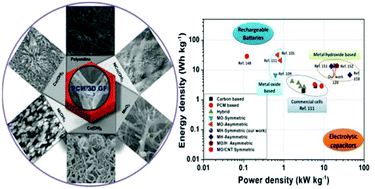Nanostructured pseudocapacitive materials decorated 3D graphene foam electrodes for next generation supercapacitors
Abstract
Nowadays, advancement in performance of proficient multifarious electrode materials lies conclusively at the core of research concerning energy storage devices. To accomplish superior capacitance performance the requirements of high capacity, better cyclic stability and good rate capability can be expected from integration of electrochemical double layer capacitor based carbonaceous materials (high power density) and pseudocapacitive based metal hydroxides/oxides or conducting polymers (high energy density). The envisioned three dimensional (3D) graphene foams are predominantly advantageous to extend potential applicability by offering a large active surface area and a highly conductive continuous porous network for fast charge transfer with decoration of nanosized pseudocapacitive materials. In this article, we review the latest methodologies and performance evaluation for several 3D graphene based metal oxides/hydroxides and conducting polymer electrodes with improved electrochemical properties for next-generation supercapacitors. The most recent research advancements of our and other groups in the field of 3D graphene based electrode materials for supercapacitors are discussed. To assess the studied materials fully, a careful interpretation and rigorous scrutiny of their electrochemical characteristics is essential. Auspiciously, both nano-structuration as well as confinement of metal hydroxides/oxides and conducting polymers onto a conducting porous 3D graphene matrix play a great role in improving the performance of electrodes mainly due to: (i) active material access over large surface area with fast charge transportation; (ii) synergetic effect of electric double layer and pseudocapacitive based charge storing.

- This article is part of the themed collection: Graphene-based Energy Devices

 Please wait while we load your content...
Please wait while we load your content...